Abstract
Colored asphalt pavements have been implemented in South Korea to enhance visibility and lane distinction; however, color fading, accelerated deterioration, and increased pothole occurrence have been noticed. As a solution, alternative materials that can be used for the construction of colored asphalt pavements are being explored. This study evaluates the feasibility of using mudstone aggregate in constructing colored asphalt pavement in South Korea. Initially, aggregate quality tests were conducted on mudstone samples to assess their suitability compared to standard criteria. To enhance the visibility and color retention of colored asphalt, addition of pigment in the colored asphalt pavement mixture was considered and evaluated. The asphalt mixtures were evaluated for deformation, crack and viscoelastic properties using the Kim test, indirect tensile (IDT) strength test, and dynamic modulus test, respectively. Results showed that mudstone aggregate exceeded quality standards and the colored asphalt mixtures demonstrated superior deformation strength and crack resistance compared to typical SMA. However, the addition of pigment slightly reduced these properties. Overall, the findings suggest mudstone aggregate as a viable alternative for constructing colored asphalt pavements, offering potential improvements in durability and color retention.
1. Introduction
The rapid growth in industrialization has promoted higher demand in the transportation sector of the country, resulting in an abrupt increase in the number of vehicles and the widening of the road network. The combination of private and public vehicles in daily traffic has caused congestion, and expanding the road network has been deemed to be insufficient and inefficient in solving the problem [1]. Moreover, this immense number of vehicles, without appropriate organization and regulations, poses significant safety risks to road users, especially pedestrians. An effective organization of road lanes has been found to be necessary to lessen the congestion and mitigate the safety risk that may lead to the accidents of road users and pedestrians [2].
As a solution to the growing number of private vehicles which cause traffic congestion, Bus Rapid Transit (BRT) has been implemented in many metropolitan areas worldwide such as New York, London, Ottawa, Sydney, and Auckland [3]. BRT aims to provide a more sustainable development of the road network by promoting public transportation over using private vehicles to lessen the traffic congestion. In BRT, special lanes are designated bus-only lanes to allow buses to avoid traffic congestion, making public transportation more efficient for commuters instead of using private vehicle to and from their destination [4]. The effectiveness of the BRT implementation relies heavily on the road user’s understanding of the new traffic rules. However, with only lane markers and street signs to indicate these implemented special lanes, it causes confusion to road users [5]. Therefore, colored pavement is utilized on the bus-only lanes to increase its visibility and the ease of road users in distinguishing them from the general road.
Colored pavement highlights the prominence of transit systems. It visually enforces dedicated transit spaces, making it clear that a lane is exclusive to buses. This implementation has reduced vehicle incursions by 30–50%, supporting on-time performance and reliability [6]. In Seoul, bus-only lanes have been applied on the city’s road network as an implementation of a policy in promoting public transportation to decrease the amount of private vehicle usage, thus minimizing the traffic congestion [1]. To make it more distinguishable, colored asphalt pavement has been used with a dark red coating on the surface and a solid blue side lane marking to indicate that private vehicles are prohibited from crossing the lane. Initially, the visibility of colored pavement was greatly distinct and clearly different from the general road after installation. However, significant fading of the dark red coating has been observed over time, especially on the wheel path, due to the passing of vehicles [7]. Moreover, the deterioration rate of the colored asphalt was found to be more severe compared to regular asphalt pavement due to the contraction and expansion induced by the pavement’s sensitivity to seasonal temperature change. Furthermore, a surge in the occurrence of potholes on the bus-only lane has been noticed, with 69% of the total bus-only lanes having potholes.
In 2011 [8], Park evaluated various coating methods according to their color maintenance when applied to colored asphalt pavement. Laboratory and field tests were conducted to evaluate the coating method’s resistance to discoloration and fading, coating adhesion, and skid resistance. Laboratory tests included the ultraviolet test, adhesion test, and Taber abrasion test, while field tests included the British pendulum test and visual inspection. The results showed that coating methods consisting of elastomers and rubber epoxy both performed better compared to other coating methods without the mentioned materials for both the laboratory and field tests. However, after 100 days of exposure to traffic, all the coating methods, regardless of the material used, showed unsatisfactory results in terms of color maintenance, abrasion, and adhesion.
In 2017 [9], the Centre for Pavement and Transportation Technology at the University of Waterloo, in collaboration with the Regional Municipality of York, investigated the functional and structural performance of BRT-dedicated colored asphalt pavement sections in Ontario, Canada after three years of service. Two types of colored asphalt pavement construction were assessed: epoxy paint-coated asphalt pavement, and red-colored modified HMA consisting of a pink granite aggregate blend and red pigment for enhanced coloring. In terms of surface texture, epoxy paint-coated asphalt pavement exhibited a low texture depth which makes it more prone to slipping accidents due to the lack of surface friction, especially in wet conditions. Meanwhile, the red-colored modified HMA had a lower surface friction compared to conventional asphalt pavement, although still sufficient in terms of safety. Moreover, aside from the noticeable tire scuffs and stains from vehicle fluid drips, red-colored modified HMA was found to have less distinction in terms of color when compared to conventional asphalt due to the pavement color’s ultraviolet-induced degradation over time. Furthermore, premature cracks, both thermal and fatigue, were observed on the red-colored modified HMA.
Based on the condition of the colored asphalt pavement in the previous studies, material used for the colored asphalt pavement should be improved to withstand the vehicle loading and maintain its functional and structural condition over time. Different-colored coatings, such as elastomers and epoxy paint, exhibited poor performance in terms of color retention. Moreover, paint-coated colored asphalt has been observed to deteriorate faster compared to typical asphalt pavement. Therefore, instead of using elastomers and rubber epoxy paint coatings as coloring for the pavement, the fundamental materials of the asphalt pavement can be altered to infuse the color into the asphalt pavement itself.
Several material replacements are currently being used in actual asphalt pavement construction for various purposes [10]. The use of reclaimed asphalt pavement (RAP), together with rejuvenating additives instead of, or in combination with, virgin aggregates and asphalt binder for the construction of asphalt pavement has been a rising technology due to its recycling potential, cost effectiveness, and positive environmental impact [11,12,13]. Steel slags, which are by-products in steel manufacturing, are also used as an alternative aggregates since they have shown improvement in the asphalt pavement’s structural performance [14,15,16]. In terms of colored asphalt pavement, inspired by the red-colored modified HMA in Ontario, mudstone that possesses natural red color can be used as an alternative aggregate. Furthermore, red pigment can also be added to the asphalt binder to intensify the distinction of the colored asphalt pavement against typical asphalt pavement. Although these mentioned alternative material and binder additives can enhance the colored asphalt pavement’s distinction and color retention, their effect on the structural capacity of the colored asphalt pavement should be initially investigated to determine if they are suitable as a pavement material.
In this study, the evaluation of the structural capacity of colored asphalt pavement with mudstone as aggregate is conducted. Moreover, the effect of the added pigment on the asphalt binder to the strength of the colored asphalt pavement is investigated. Initially, the quality of mudstone aggregate was evaluated based on the Korean standards. Subsequently, three laboratory tests were conducted to three different laboratory specimens composed of different asphalt mixture: typical stone mastic asphalt (SMA) to serve as the baseline reference of the comparison of results, colored SMA replacing only the aggregate with mudstone, and colored SMA with mudstone as aggregate and additional red pigment in the binder. The laboratory tests included the Kim test, indirect tensile (IDT) strength test, and dynamic modulus test, which measure the deformation resistance, crack resistance, and the viscoelastic properties of the pavement material. Figure 1 summarizes the flow of this study.
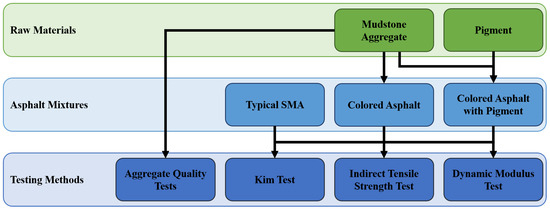
Figure 1.
Research diagram of this study.
2. Materials and Methods
2.1. Materials
2.1.1. Mudstones Aggregates
Composition
Mudstone is a sedimentary rock formed from the solidification of clay, containing clay and silt in similar proportions, and is generally non-fissile. When this rock develops fissility, it is referred to as shale, characterized by thin, parallel fissures along the laminar surface. Shale, or “blood rock”, peels thinly parallel to the stratified surface among heterogeneous sedimentary rocks, whereas mudstone lacks this peelability due to its lower stratification and fissility. This study utilized red mudstone aggregates sourced from Seoksan Mountain in Chungcheongnam-do. Based on the spectroscopy results, the compositional analysis of the red mudstone revealed that it consists of 66.5% SiO2, 13.2% Al2O3, and 4.12% Fe2O3, with these three components making up over 80% of the rock’s composition. Table 1 shows the percentage of the mudstone components together with the percentage of granite components for comparison.

Table 1.
Percentage of the composition of mudstone and granite.
In comparison, granite, commonly used as an aggregate in asphalt concrete mixtures in Korea [17], comprises 71.8% SiO2, 14.3% Al2O3, and 4.1% Fe2O3, with these three components constituting over 90% of the granite’s composition, also shown in Table 1. Like red mudstone, granite’s main components account for over 80% of its composition. The differences in the presence or absence of red aggregates are attributed to variations in the quantities of Fe2O3. Given that more than 80% of the components are similar, it is inferred that red mudstone can exhibit comparable aggregate performance to granite.
Production
For this study, the aggregate plant where the mudstone aggregates were sourced out is Seondo Industry Co., Ltd., situated in Gongju City, Republic of Korea. In this aggregate plant, the mudstone aggregates are reduced to the desired size using a combination of three processes: crushing using the jaw crusher, crushing by the cone crusher, and refining using the vertical shaft impactor (VSI). The process of mudstone aggregates is shown in Figure 2.
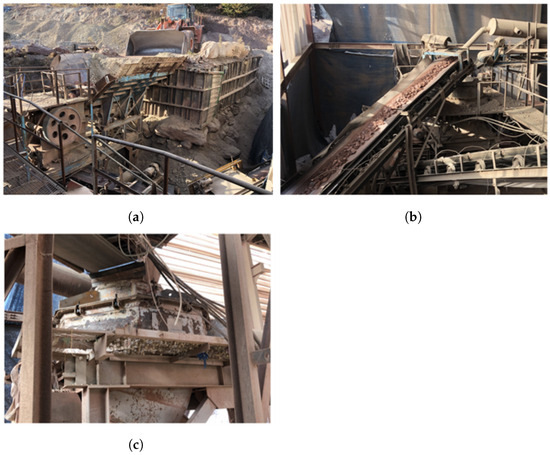
Figure 2.
Process of mudstone aggregate production. (a) Jaw crusher. (b) Cone crusher. (c) Vertical shaft impactor.
The jaw crusher is a compression-type crusher used predominantly for the primary crushing of rocks and ores. In operation, rocks are fed into the crusher, where they are compressed between a fixed jaw and a moving jaw, resulting in impact and compressive forces that fracture the material. The crushed material then descends through the discharge opening by gravity and the force of the crusher. Jaw crushers are capable of handling large rocks exceeding 1000 mm in size, with an average reduction ratio—defined as the ratio of feed size to product size—ranging from 4 to 6.
After reducing the size of the mudstone aggregates using jaw crusher, the resulting aggregates are then fed to the cone crusher. The cone crusher operates by compressing material between a gyrating mantle and a concave surface. The material is fed into the crusher, where it undergoes gradual size reduction due to the eccentric movement of the mantle, which creates a narrowing gap for compression and shearing forces to break down the material. This process ensures a consistent product size, which can be adjusted via the closed side setting (CSS) for optimal performance.
Lastly, after obtaining a more consistent size of the mudstone aggregates, the aggregates are refined using the VSI. The VSI refines aggregates and improves their shape by using high-speed impact forces. Material is fed into the center of the rotor, which spins at high speeds, using centrifugal force to accelerate the material outward. This high-speed material is then directed to collide with anvils or a rock bed surrounding the rotor, causing the material to break upon impact. This process of high-velocity collisions ensures the material is finely crushed and helps produce aggregates with improved shape and particle consistency, making VSI an essential tool for creating high-quality construction materials.
Gradation
In this study, two sizes of coarse aggregates are replaced by mudstone aggregates, 13 mm and 10 mm, to produce the colored asphalt mixture. In accordance with the Korean standard for the use of single-particle size aggregates in the production and construction of asphalt mixtures, the 13 mm and 10 mm mudstone aggregates are sieved to satisfy the required gradation for each particle size. Table 2 summarizes the required percentage gradation of each single-particle size aggregate, and Figure 3 shows the gradation of the mudstone coarse aggregates. Additionally, samples of each particle size of the mudstone coarse aggregates are shown in Figure 4 for visualization.

Table 2.
Required aggregate gradation for 13 mm and 10 mm single-particle size coarse aggregates.
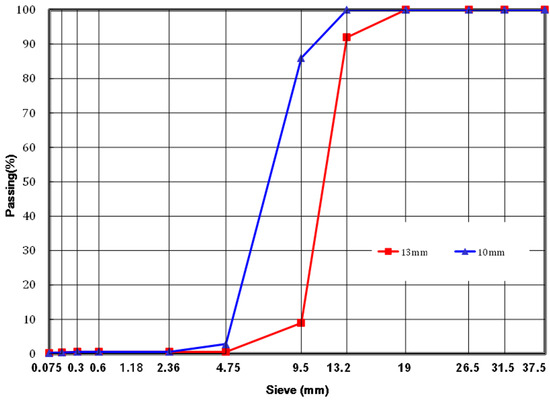
Figure 3.
Mudstone coarse aggregate gradation.

Figure 4.
Sample photos of (a) 13 mm and (b) 10 mm mudstone aggregates.
2.1.2. Mix Design
For the mix design of the asphalt mixtures, stone mastic asphalt (SMA) is the type of asphalt mixture that is chosen for the colored asphalt since it is commonly used for bus lanes in Korea. For the binder, PG 76-22 asphalt binder supplied by SK Energy Co., Ltd. from Seoul, Republic of Korea is chosen because the bus lane in Korea typically uses a stiffer modified binder due to the heavy traffic.
The combined aggregate gradation for the SMA mixture used in this study is shown in Figure 5. The upper and lower limits of the combined gradation for the SMA mixture are obtained from the Korean standard for the SMA mixture [18]. Three types of asphalt materials are considered in this study: typical SMA with usual granite aggregates, colored asphalt with 13 mm and 10 mm coarse aggregates replaced with mudstone aggregates, and pigmented colored asphalt with the same alteration to the coarse aggregate and additional 1.5% red pigment to the binder for enhanced color visibility of the asphalt mixture. Figure 6 presents a side-by-side comparison of the three asphalt materials.
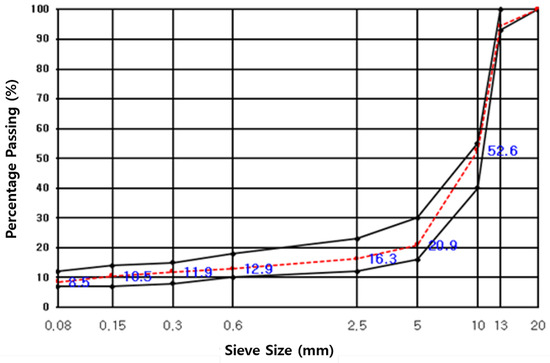
Figure 5.
SMA combined aggregate gradation.
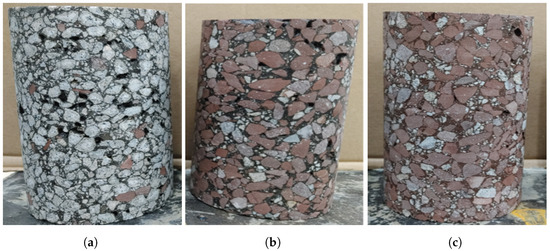
Figure 6.
Test specimen for (a) typical SMA mixture, (b) colored asphalt mixture, and (c) colored asphalt mixture with additional pigment.
The pigment used is a synthetic iron oxide in powder form with 95% iron oxide and the remaining 5% is a combination of aluminum oxide and silicon dioxide. The iron oxide pigment powder lies between 325 mesh and 1250 mesh with a particle size of less than 44 microns. Furthermore, the properties of the normal binder and the binder with pigment are summarized in Table 3.

Table 3.
Comparison of the rheological properties of the normal binder and the binder with pigment.
Based on the standard mix design of the SMA mixture in South Korea [18], shown in Table 4, the asphalt binder content of a SMA mixture with a nominal maximum aggregate size (NMAS) of 13 mm should be greater than or equal to 6.2%. Hence, in order to obtain the optimal asphalt content, three sets of SMA specimens with asphalt contents of 6.2%, 6.5%, and 6.8% are fabricated. The air void, degree of saturation, and VMA (Void in the Mineral Aggregate) of the test specimens are obtained and compared to identify the optimal binder content for the SMA mixture. Figure 7 present the results of the tests and, based on the standards, it is found that the optimum binder content for the SMA mixture is 6.8%. Thus, 6.8% of the asphalt binder content is used for the fabrication of the SMA mixtures for this study.

Table 4.
Standard for mix design of the SMA mixture with 13 mm NMAS.
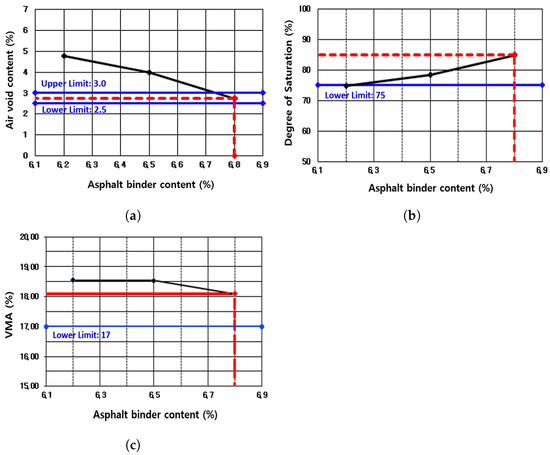
Figure 7.
Graph of the volumetric properties for each asphalt binder content: (a) Air void content. (b) Degree of saturation. (c) VMA.
2.2. Methods
2.2.1. Aggregate Quality Tests
To examine the feasibility of mudstone aggregates as material for asphalt pavement, series of tests were conducted in accordance with the standards included in the asphalt concrete paving construction guidelines [18]. Properties of the mudstone aggregate were identified such as density, absorption rate, coating rate after dynamic immersion test, flatness index, stability, abrasion rate, and percentage of fractured particles in coarse aggregate. These properties describe the effectiveness of a material when used to construct asphalt pavement. Table 5 summarizes the aggregate properties investigated, the criteria of the aggregate property, and the standards of the test methods used to obtain the properties of the mudstone aggregate.

Table 5.
Aggregate property test standards and criteria.
2.2.2. Kim Test
The Kim test is a novel testing method developed in South Korea that aims to evaluate the asphalt mixture’s deformation mechanism when subjected to wheel loading [20,25]. Typically, the Marshall test is used to assess the resistance of the asphalt mixture against plastic deformation. However, due to the inward squeezing pressure load application of the Marshall test, it was found that the load deformation mechanism of the Marshall test does not represent the wheel load application on the pavement, which is the main cause of plastic deformation [26]. Thus, a new testing method, the Kim test, was developed in South Korea, wherein the same type of specimen is still utilized, similar to the Marshall test, but the loading mechanism is modified to represent the application of the wheel load on the asphalt pavement more accurately. Since the development and standardization of the Kim test, it has been implemented in several studies [27,28,29] as an alternative testing method in measuring the asphalt mixture’s resistance to plastic deformation.
In accordance with the testing method standardized by the Ministry of Land, Infrastructure, and Transportation [20], the Kim test was conducted as shown in Figure 8. Marshall specimens with a diameter of 100 mm and thickness range of 60–65 mm were fabricated and preconditioned in the water bath for 30 min at 60 °C. After preconditioning, each specimen was placed in a special mold for Kim test. The mold has a tube guide for the loading rod to ensure that the loading application is maintained at a right angle to the test specimen. The loading rod, having a circular cross-section with a diameter of 40 mm and a rounded corner with a radius of 10 mm at the loading surface of the rod, is geometrically designed to simulate circular tire imprints of a single-wheel loading. The Marshall tester was used to apply the static compressive load on the test specimen with a loading rate of 30 mm/min until it reached failure. For each material, three testing repetitions were performed on three test specimens to consider the repeatability and precision of the test results. From the stress–strain curve produced from the testing, the maximum load and vertical depth were obtained, and the deformation strength was computed using the following equation:
where is the deformation strength in MPa; P is the maximum load in N; and y is the maximum vertical depth in mm.
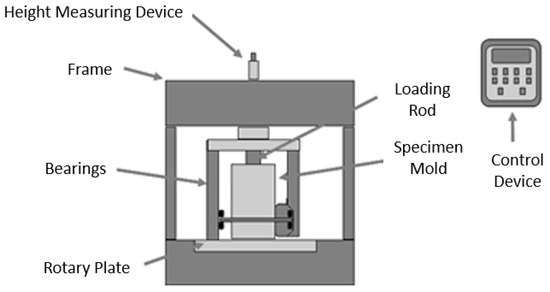
Figure 8.
Illustration of a Kim test setup.
2.2.3. Indirect Tensile Strength Test
The indirect tensile (IDT) strength test for asphalt mixture as outlined in ASTM D6931-07 [30], is a testing method used to determine the crack resistance of compacted bituminous mixtures. This test is essential for evaluating the performance and durability of asphalt under tensile stress, which is crucial in the formation and propagation of cracks. The IDT strength test was performed using a D25 Universal Testing Machine.
In compliance with ASTM D6931-07, three test specimens for each material, to consider repeatability and precision, were fabricated with a diameter and thickness of 100 mm and 60 mm, respectively. The specimens were compacted using a Marshall compactor, and four thickness and diameter measurements were taken on the specimens using a vernier caliper to calculate the test specimen’s average thickness and diameter. Before the IDT strength test, the test specimens were stored in a chamber with temperature set to 25 °C, matching the testing temperature, for 24 h to ensure that the internal temperature of the test specimens were uniform. After preconditioning, the IDT strength test was performed on each test specimen by subjecting it to a compressive load with a uniform test loading rate of 50 mm/min until failure, and the maximum load at failure was recorded. The IDT strength of the test specimens was calculated as follows:
where is the IDT strength in MPa; P is the maximum load at failure in N; t is the average specimen height in mm; and D is the average specimen diameter in mm.
Based on the Korean standard [18], the criterion for the minimum IDT strength of surface layer of an asphalt pavement is 0.80 MPa.
2.2.4. Dynamic Modulus Test
To describe the viscoelastic properties of the colored asphalt mixtures, the dynamic modulus test was conducted using a modular asphalt tester manufactured by IPC Global. Basically, the dynamic modulus test simulates various combinations of testing temperatures and loading frequencies to obtain the test specimen’s response in a wide array of pavement loading scenarios. From this collection of responses, the dynamic modulus curve at a certain temperature is produced, which represents the asphalt mixture’s elastic modulus at a certain temperature and loading frequency.
In accordance with AASHTO T342 [31], the dynamic modulus test in this study was performed as follows:
- Three cylindrical specimens, one per each asphalt mixture to be tested, with a height of 150 mm and a diameter of 100 mm were fabricated.
- Hexagonal gauge points were installed at four sides of each test specimen, where the linear variable displacement transducers (LVDT) were placed. The LVDT was used to acquire the vertical strain response induced by the load. To ensure that the placement of the LVDTs was perfectly aligned and evenly spaced, a gauge point fixing jig device was used.
- After placement of the hexagonal gauge points and attachment of the LVDTs, the test specimen was placed in the modular asphalt tester. The test specimens were subjected to sinusoidal loading with a strain rate between 50 and 70 .
- Five testing temperatures (−5, 5, 20, 40, and 54 °C) were considered in this experiment. To achieve a uniform temperature of the test specimens, the test specimens were preconditioned according to the testing temperature by storing the test specimens in a chamber set at the testing temperature before each test. For each testing temperature, six loading frequencies were implemented: 25, 10, 5, 1, 0.5, and 0.1 Hz.
- After calculating the dynamic modulus and phase angle for each combination of testing temperature and loading frequency from the obtained strain response and applied compressive load, a dynamic modulus master curve and phase angle graph of each test specimen at 5 °C reference temperature was constructed using the time–temperature superposition principle.
3. Results and Discussions
3.1. Aggregate Quality Tests
Based on the tests conducted to evaluate the suitability of mudstone aggregate as material for asphalt pavement, it was found that mudstone aggregates satisfy the qualifications of the aggregate quality in accordance with the standards of the Ministry of Land, Infrastructure and Transport (MOLIT) of South Korea. The results and criteria are summarized in Table 6.

Table 6.
Results of the aggregate property evaluation.
Among the aggregate qualities investigated, it can be observed that the abrasion rate, stability, and coating rate of the mudstone aggregate after conducting dynamic immersion are excellent based on the criteria of the standards. The abrasion rate of the mudstone aggregate was found to be less than the criteria for both 13 mm and 10 mm aggregates. This implies higher durability and reduced deformation for the asphalt pavement. Moreover, the stability of mudstone aggregate was found to be 4.1% and 4.5% for 13 mm and 10 mm aggregates, respectively, indicating high resistance to freezing, thawing, and weathering. Furthermore, the excellent coating rate after dynamic immersion test, with a value of 67%, implies that the asphalt mixture with mudstone aggregate has a significant resistance to moisture damage and aggregate stripping. Therefore, it was determined that the use of lime or liquid anti-stripping agents is unnecessary for colored asphalt pavement.
3.1.1. Kim Test
The results of the Kim test for the three test specimens are shown in Figure 9. It can be observed that the colored asphalt mixture’s deformation strength, with a value of 3.02 MPa on the average, is significantly superior compared to the other materials with average values of 2.60 MPa and 2.41 MPa for typical SMA and colored asphalt with pigment, respectively.
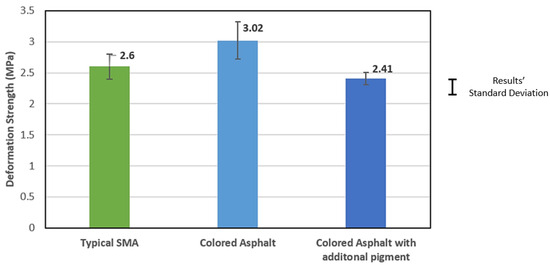
Figure 9.
Kim test results.
The interlock provided by mudstone aggregate offers substantial support against deformation. As illustrated in Figure 4, the multifaceted shape of mudstone aggregates enhances the aggregate-to-aggregate interaction. Additionally, based on the flatness rate of the mudstone aggregates, the rounded shape of these aggregates contributes to their resistance to deformation. In asphalt pavement, flat and elongated aggregates tend to permit plastic deformation due to their shape and the lack of interlock with other aggregates. In contrast, rounded aggregates are more likely to maintain their form under traffic load due to their effective interaction with other aggregates. Also, the mudstone aggregate’s high stability and resistance to abrasion, as shown in Table 6, are also factors in the increased resistance to deformation of the colored asphalt pavement. However, test results indicate that the addition of pigment adversely affects the deformation resistance of colored asphalt pavement. When pigment is incorporated into the asphalt binder, the stiffness of the binder decreases, thereby reducing its resistance to rutting.
3.1.2. Indirect Tensile Strength Test
For the IDT strength test results, Figure 10 shows the comparison of the average IDT strength at the failure of each material. Based on the results, all the materials passed the IDT strength criteria for surface pavement layer of at least 0.80 MPa. The use of modified binder for the three asphalt mixtures provided sufficient cohesive and adhesive bond within the asphalt mixture. Hence, all of the materials are suitable as a surface pavement layer in terms of crack resistance.
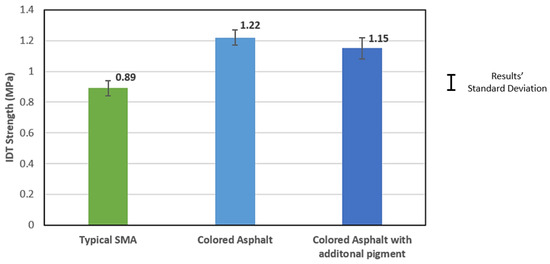
Figure 10.
IDT strength test results.
Comparing the three asphalt mixtures, both the colored asphalt pavement, with and without additional pigment, performed better in terms of IDT strength than the typical SMA mixture. It implies that the crack resistance of the colored asphalt pavement is superior to that of the typical SMA. Moreover, it can be observed that the IDT strength of the colored pavement with additional pigment is lower than that of the colored pavement without additional pigment, which is also the case for the Kim test results. The additional pigment lowers the stiffness of the binder, making it more susceptible to deformation and cracks.
3.1.3. Dynamic Modulus Test
As the results of the dynamic modulus tests conducted on the test specimens, Figure 11, Figure 12 and Figure 13 show the comparison of the dynamic modulus master curve and phase angle of the test specimens. The dynamic modulus master curve is presented at two different scales, semi-logarithmic and log–log scales, to highlight the material’s behavior in both low and high temperature, respectively. Meanwhile, the phase angle provides insights into the elastic behavior characteristics of these mixtures. A low phase angle indicates a high elastic response, while a high phase angle suggests lower elastic properties and more viscous behavior.
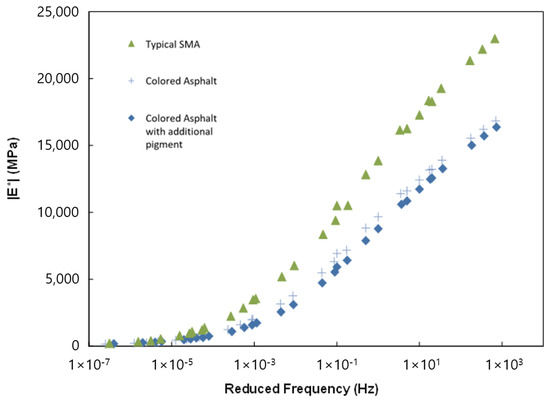
Figure 11.
Dynamic modulus master curve in semi-logarithmic scale.
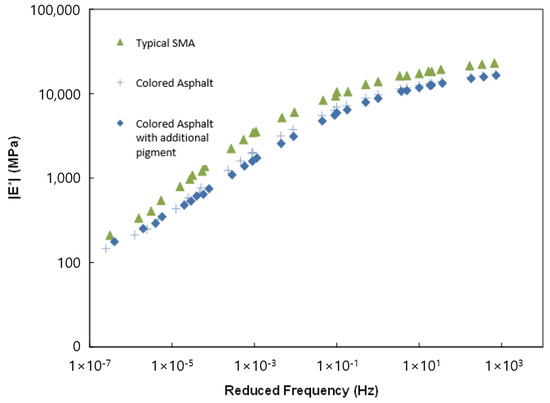
Figure 12.
Dynamic modulus master curve in log–log scale.
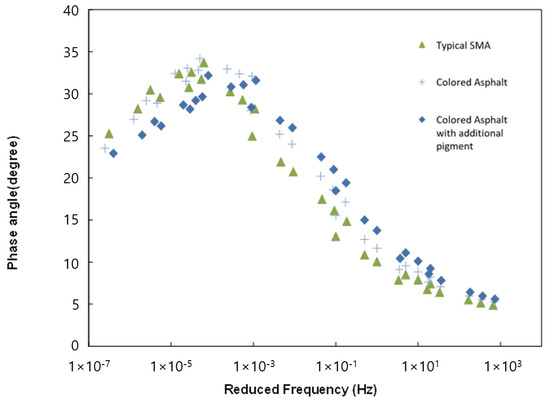
Figure 13.
Phase angle of the test specimens.
The results demonstrate that the typical SMA exhibits a higher elastic modulus across various temperatures compared to both colored asphalt and colored asphalt with additional pigment. The elastic moduli of the colored asphalt and colored asphalt with additional pigment remain almost identical across all temperature ranges. Notably, the higher elastic modulus of the typical SMA at lower temperatures indicates increased stiffness and brittleness, which could potentially reduce its crack resistance. Conversely, at elevated temperatures, all three mixtures show similar elastic moduli, suggesting comparable resistance to plastic deformation across the mixtures.
Moreover, it can be observed that the three asphalt mixtures have the same trend of the phase angle in the span of the reduced frequency. This implies that all three asphalt mixtures exhibit elastic behavior at low temperatures, with the elastic modulus decreasing as the temperature rises. Beyond a certain temperature threshold, the aggregate begins to dominate the elastic response, shifting the behavior towards that governed by aggregate–aggregate interactions, and the phase angle subsequently decreases. This phenomenon indicates that at lower phase angles, the mixture demonstrates more pronounced elastic behavior, while higher phase angles indicate the simultaneous interaction of both viscous and elastic characteristics.
4. Summary and Conclusions
In conclusion, this study evaluated the feasibility of mudstone aggregate as an alternative material in the construction of colored asphalt pavement. Based on the test results, the following findings were drawn from the study:
- The results of the aggregate quality tests indicate that mudstone aggregates satisfy the criteria established by the Ministry of Land, Infrastructure and Transport (MOLIT) of South Korea. The mudstone aggregate exhibited excellent abrasion rate, stability, and coating rate, meeting standards. These results show that the mudstone aggregate possesses high durability, stability, and resistance to deformation and moisture damage, making it suitable for use in asphalt pavement.
- The Kim test results revealed that the colored asphalt mixture exhibited superior deformation strength, which resulted from the multifaceted and rounded shape of the mudstone aggregates that enhance aggregate-to-aggregate interaction. However, the addition of pigment to the asphalt binder was found to decrease the deformation resistance of the colored asphalt pavement due to the reduced stiffness of the binder.
- In the IDT strength test, all materials tested surpassed the IDT strength criterion for surface pavement layers. Furthermore, the colored asphalt pavement, regardless of the presence of pigment, was found to have superior crack resistance when compared to typical SMA. However, when colored asphalts with and without pigment were compared, similar to the Kim test results, the addition of pigment was observed to lower the IDT strength due to the reduced stiffness of the binder.
- Dynamic modulus test results show that typical SMA has a higher elastic modulus across various temperatures compared to colored asphalt mixtures, indicating greater stiffness and brittleness, potentially reducing crack resistance. At elevated temperatures, all mixtures have similar elastic moduli, suggesting comparable resistance to plastic deformation. The phase angle trends indicate that all three mixtures exhibit elastic behavior at low temperatures, shifting to aggregate-dominated behavior at higher temperatures.
Overall, the mudstone aggregate demonstrated excellent properties for use in asphalt pavement, including high durability, stability, and resistance to deformation and moisture damage. The colored asphalt mixtures showed superior performance in terms of deformation strength and crack resistance, although the addition of pigment reduced these properties. Additional tests should be performed to thoroughly examine the effects of additional pigment in the performance of colored asphalt pavement. Nonetheless, these findings suggest that mudstone aggregate is a viable alternative in constructing colored asphalt pavement. For future studies, the effectiveness of the mudstone aggregate replacement with respect to the color retention of colored asphalt shall be evaluated.
Author Contributions
Conceptualization, J.W.K. and C.E.; methodology, J.W.K. and C.E.; validation, J.W.K. and C.E.; formal analysis, C.E.; investigation, J.W.K. and C.E.; resources, J.W.K.; data curation, C.E.; writing—original draft preparation, C.E.; writing—review and editing, J.W.K.; visualization, C.E.; supervision, J.W.K.; project administration, J.W.K.; funding acquisition, J.W.K. All authors have read and agreed to the published version of the manuscript.
Funding
This research was conducted under the KICT Research Program (Project No. 20240499-001, Development of a mobile plant equipped with smart devices and machines for the production and maintenance of 3 ton/h asphalt mixtures for emergency road maintenance and excavation-restoration work) funded by the Ministry of Trade, Industry, and Energy.
Institutional Review Board Statement
Not applicable.
Informed Consent Statement
Not applicable.
Data Availability Statement
The data presented in this study are available on request from the corresponding author. The data are not publicly available due to privacy.
Conflicts of Interest
The authors declare no conflicts of interest.
References
- Sung, N.M.; Lim, J.K.; Park, J.S.; Kim, Y.H.; Cho, H.S.; Kim, H.K.; Park, J.H.; Lee, H.K. Korea’s Best Practice in the Transport Sector: Road Transport Policy in Korea; The Korea Transport Institute: Goyang City, Republic of Korea, 2013. [Google Scholar]
- Taylor, W.C. Colored paavement for traffic guidance. Highw. Res. Board 1968, 221, 1–14. [Google Scholar]
- Varanubu, S.; Farashah, M.K.; El-Hakim, M.; Tighe, S. Coloured Asphalt Bus Rapid Transit Lanes in The Regional Municipality of York: Integrating Laboratory Performance Testing into Sustainable Pavement Asset Management. In Proceedings of the 2016 Conference of the Transportation Association of Canada (TAC), Toronto, ON, Canada, 25–28 September 2016. [Google Scholar]
- Sakamoto, K.; Abhayantha, C.; Kubota, H. Effectiveness of Bus Priority Lane as Countermeasure for Congestion. Transp. Res. Rec. 2007, 2034, 103–111. [Google Scholar] [CrossRef]
- Kawther, K. Colored asphalt and street print are decorating paving in public spaces. MATEC Web Conf. 2018, 162, 05027. [Google Scholar] [CrossRef][Green Version]
- Lindley, J. Official Ruling 3(09)-24(I)—Application of Colored Pavement: Aug 15, 2013; Technical Report; Federal Highway Administration: Washington, DC, USA, 2013.
- Jeong, K.; Kim, J.; Yum, W.; Hwang, S. Development of High Colorfastness Color Asphalt Pavement for Traffic Safety; Technical Report KICT 2020-114; Korea Institute of Civil Engineering and Building Technology: Goyang City, Republic of Korea, 2020. [Google Scholar]
- Park, T.S. Evaluation of Color Coating Method for Color Maintenance of Color Asphalt Pavement. J. Korean Soc. Road Eng. 2018, 13, 93–101. [Google Scholar] [CrossRef][Green Version]
- Liu, Q.; Varamini, S.; Tighe, S. Field Evaluation of Red-Coloured Hot Mix Asphalt Pavements for Bus Rapid Transit Lanes in Ontario, Canada. Coatings 2017, 7, 58. [Google Scholar] [CrossRef]
- Raschia, S.; Tattolo, S. Use of alternative aggregates for the production of hot-mix asphalt surface layers: A performance evaluation. Constr. Build. Mater. 2022, 345, 128369. [Google Scholar] [CrossRef]
- Antunes, V.; Neves, J.; Freire, A.C. Performance Assessment of Reclaimed Asphalt Pavement (RAP) in Road Surface Mixtures. Recycling 2021, 6, 32. [Google Scholar] [CrossRef]
- AlKhede, S. Environment-friendly recycled asphalt pavement design for road maintenance applications. Environ. Dev. Sustain. 2022, 24, 14210–14234. [Google Scholar] [CrossRef] [PubMed]
- Gulzar, S.; Fried, A.; Preciado, J.; Castorena, C.; Underwood, S.; Habbouche, J.; Boz, I. Towards sustainable roads: A State-of-the-art review on the use of recycling agents in recycled asphalt mixtures. J. Clean. Prod. 2023, 406, 136994. [Google Scholar] [CrossRef]
- Roberto, A.; Bisanti, F.; Pizzati, M.; Mantovani, L.; Romeo, E.; Tebaldi, G. Stiffening effects of LFS slags reused as filler in asphalt mixtures. Constr. Build. Mater. 2023, 402, 132702. [Google Scholar] [CrossRef]
- Chen, X.; Wan, B.; Wang, Y.; Dong, Q. Investigation on the temperature distribution characteristics of steel slag asphalt mixture under different microwave heating and cooling methods. Constr. Build. Mater. 2024, 425, 136004. [Google Scholar] [CrossRef]
- Zhong, T.; Zheng, Y.; Chen, Z.; Yao, L.; Zhang, W.; Zhu, Y.; Fu, L. Utilization of steel slag as coarse aggregate and filler in stone mastic asphalt (SMA) mixture: Engineering performance, environmental impact and economic benefits analysis. J. Clean. Prod. 2024, 450, 141891. [Google Scholar] [CrossRef]
- Han, S.; Baek, C. Evaluation of Properties of Asphalt Concrete Mixture Using Basalt Aggregate from Jeju Island. Buildings 2023, 13, 3119. [Google Scholar] [CrossRef]
- SMA Pavement Production and Construction Guidelines. In Asphalt Concrete Pavement Construction Guidelines; Ministry of Land, Infrastructure and Transport: Sejong, Republic of Korea, 2021.
- KS F 2503; Standard Test Method for Density and Absorption of Coarse Aggregate. Korean Standards Association: Seoul, Republic of Korea, 2014.
- Annexes and Appendices. In Integrated Guidelines for Pavement; Ministry of Land, Infrastructure and Transport: Sejong, Republic of Korea, 2021.
- KS F 2575; Standard Test Method for Flat or Elongated Particles in Coarse Aggregate. Korean Standards Association: Seoul, Republic of Korea, 2023.
- KS F 2508; Method of Test for Resistance to Abrasion of Coarse Aggregate by Use of the Los Angeles Machine. Korean Standards Association: Seoul, Republic of Korea, 2022.
- KS F 2507; Method of Test for Soundness of Aggregates by Use of Sodium Sulfate. Korean Standards Association: Seoul, Republic of Korea, 2017.
- ASTM D5821; Standard Test Method for Determining the Percentage of Fractured Particles in Coarse Aggregate. American Society for Testing and Materials: West Conshohocken, PA, USA, 2017.
- Mitchell, M.; Link, R.; Kim, K.; Amirkhanian, S.; Kim, H.; Lee, M.; Doh, Y. A New Static Strength Test for Characterization of Rutting of Dense-Graded Asphalt Mixtures. J. Test. Eval. 2011, 39, 59–68. [Google Scholar] [CrossRef]
- Lee, S.J.; Kim, S.; Kim, K.W. Comparative Study of Kim Test and Repeated Load Creep Test for Rutting Estimation of Asphalt Mixtures. J. Korean Asph. Inst. 2012, 2, 62–68. [Google Scholar]
- Kim, W.; Kim, Y.; Kim, S.; Kim, K.W. Correlation analysis of rut data of field asphalt pavements and semi-ALF test with deformation strength (SD). J. Korean Asph. Inst. 2023, 13, 36–48. [Google Scholar] [CrossRef]
- Kim, S.; Choi, C.J.; Kim, K.W. Feasibility of Estimating Rut Resistance of SMA Mixture by Static Loading Test Using Confined Specimen. J. Korean Soc. Agric. Eng. 2019, 61, 43–53. [Google Scholar] [CrossRef]
- Mrema, A.H.; Noh, S.H.; Kwon, O.S.; Lee, J.J. Performance of Glass Wool Fibers in Asphalt Concrete Mixtures. Materials 2020, 13, 4699. [Google Scholar] [CrossRef] [PubMed]
- ASTM D6931-17; Standard Test Method for Indirect Tensile (IDT) Strength of Bituminous Mixtures. American Society for Testing and Materials: West Conshohocken, PA, USA, 2017.
- AASHTO T 342; Standard Method of Test for Determining Dynamic Modulus of Hot Mix Asphalt (HMA). American Association of State Highway and Transportation Officials: Washington, DC, USA, 2022.
Disclaimer/Publisher’s Note: The statements, opinions and data contained in all publications are solely those of the individual author(s) and contributor(s) and not of MDPI and/or the editor(s). MDPI and/or the editor(s) disclaim responsibility for any injury to people or property resulting from any ideas, methods, instructions or products referred to in the content. |
© 2024 by the authors. Licensee MDPI, Basel, Switzerland. This article is an open access article distributed under the terms and conditions of the Creative Commons Attribution (CC BY) license (https://creativecommons.org/licenses/by/4.0/).